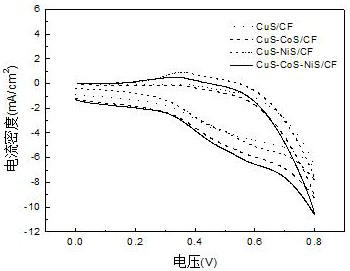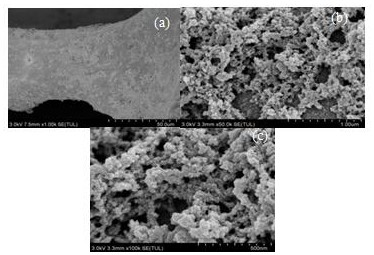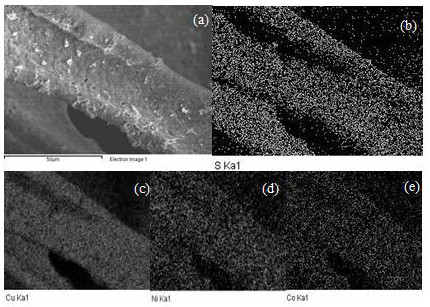Non-enzyme glucose electrochemical sensor and preparation method thereof
An electrochemical and glucose technology, applied in the field of biochemical sensors, can solve the problem of low catalytic activity of transition metal sulfides, achieve good anti-interference ability and stability, mild preparation conditions, and simple and fast preparation methods
- Summary
- Abstract
- Description
- Claims
- Application Information
AI Technical Summary
Problems solved by technology
Method used
Image
Examples
Embodiment 1
[0033] (1) Cut the copper foam into 0.8×1.5 cm 2 Sonicate in acetone and ethanol at 100kHz for 10min each.
[0034] (2) Prepare 0.5 M mixed solution of cobalt sulfate and nickel sulfate (the molar ratio of cobalt to nickel is 1:1) A, and then prepare 0.5 M sodium sulfide solution. As a comparison, 0.5 M cobalt sulfate solution B and 0.5 M nickel sulfate solution C were prepared separately.
[0035] (3) Immerse foamed copper in the above solution A for 1 min, place it upright on the filter paper with tweezers for 15 s, then immerse it in the above sodium sulfide solution for 1 min, rinse with water to obtain a copper-cobalt-nickel composite sulfide electrode. As a comparison, another three pieces of foamed copper were taken, one piece was directly immersed in sodium sulfide solution for 1 min, and the copper sulfide electrode was obtained after washing with water; the other two pieces were respectively immersed in B and C solutions for 1 min, and they were placed upright on t...
Embodiment 2
[0039] (1) Cut the copper foam into 0.8×1.5 cm 2 The squares were sonicated in acetone and ethanol at 100 kHz for 10 min each.
[0040] (2) Prepare 0.5 M cobalt sulfate and nickel sulfate mixed solution (the molar ratio of cobalt to nickel is 1:1), and prepare 0.5 M sodium sulfide solution.
[0041] (3) Immerse the foamed copper in the above cobalt-nickel mixed solution for 1 min, place it upright on the filter paper for 15 s with tweezers, then immerse it in the above sodium sulfide solution for 1 min, and rinse it with water to obtain a copper-cobalt-nickel composite sulfide electrode.
[0042] (4) Dry the copper-cobalt-nickel composite sulfide electrode obtained in step (3) at 60 °C for 3 h.
[0043] (5) The copper-cobalt-nickel composite sulfide electrode obtained in step (4) was used as the working electrode, and a three-electrode system was formed with the counter electrode (platinum wire electrode) and the reference electrode (Ag / AgCl / 3M KCl). Hua CHI660C electrochem...
Embodiment 3
[0048] The copper-cobalt-nickel trimetallic sulfide enzyme-free glucose sensor constructed above was applied to the anti-interference performance test. The specific steps and results were as follows: 0.1 mM glucose, 0.01 mM ascorbic acid (AA), 0.01 mM ascorbic acid (AA), 0.01 mM dopamine (DA), 0.01 mM uric acid (UA), 0.1 mM glucose, and time-current curves were tested. Such as Figure 6 As shown, the copper-cobalt-nickel enzyme-free glucose sensor constructed by the present invention has no obvious current response phenomenon for common small molecule substances ascorbic acid, uric acid, and dopamine in human blood, and has good anti-interference ability. The presence of will not affect the measurement results of the modified electrode for glucose concentration.
PUM
| Property | Measurement | Unit |
|---|---|---|
| Sensitivity | aaaaa | aaaaa |
| Sensitivity | aaaaa | aaaaa |
Abstract
Description
Claims
Application Information
 Login to View More
Login to View More - Generate Ideas
- Intellectual Property
- Life Sciences
- Materials
- Tech Scout
- Unparalleled Data Quality
- Higher Quality Content
- 60% Fewer Hallucinations
Browse by: Latest US Patents, China's latest patents, Technical Efficacy Thesaurus, Application Domain, Technology Topic, Popular Technical Reports.
© 2025 PatSnap. All rights reserved.Legal|Privacy policy|Modern Slavery Act Transparency Statement|Sitemap|About US| Contact US: help@patsnap.com



